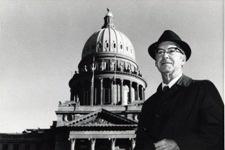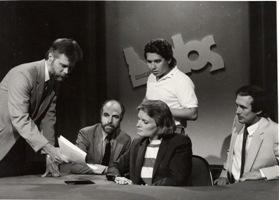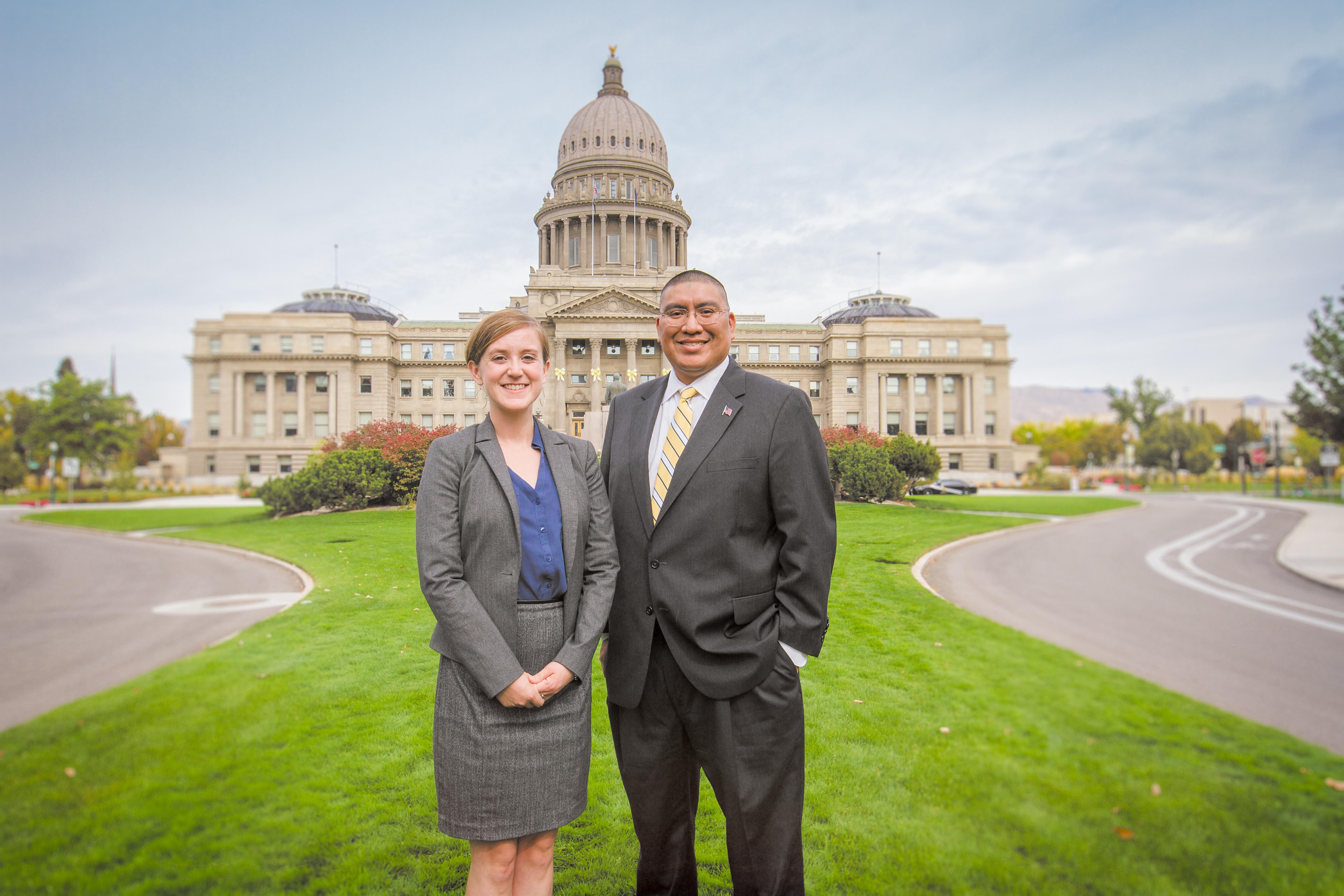History
A History of Idaho Reports
The West's longest running legislative program has a storied history that dates back over five decades.
During those many years of service to Idahoans, our legislative show has endured several name changes, as well as numerous hosts and format changes. But it has always managed to attract and maintain a dedicated viewership that values political analysis and in-depth reporting of Idaho's legislative proceedings.
In January of 1972, KAID-TV in Boise began broadcasting the first program devoted solely to the Idaho legislative process. The host was Gene Shumate.
In 1973, Jeff Seward joined the show. "Gene wanted some help with the show," said Jeff, "and I spent the 1973 session doing a daily 3-4 minute report exclusively on the subject of tax and budget issues."
By 1974, Gene Shumate had left the show and KAID-TV recruited Idaho Statesman reporter Mindy Cameron to co-anchor with Jeff Seward. "I covered the Senate and the Joint Committee; she covered the House," remembers Jeff. "The next year, 1975, we switched in order to expand our contacts and knowledge."
"The show in those early years was really a live show. We had no film or video capability at the Statehouse, no tele-prompters," said Jeff. "We went on live every night at about 5:30 and read stories out of copy in our hands and did interviews with legislators, lobbyists and state officials. It was a lot of fun, and we established public television as the news source for legislative happenings in the state. One local commercial TV news director even thanked me personally one day for doing all this coverage because that meant he could get away without doing any at all."
Jeff Seward continued to anchor the program with the help of new reporters Jean McNeil and Sid Sprecher until 1977, when Jean and Sid took over the anchoring duties.
KAID's chief engineer at the time, Vaun McArthur, remembers those early years as "an interesting hassle. We were running thick cables everywhere," he says, "dragging them through the hallways, climbing out on ledges. Legislators were always tripping over them and getting upset."
The program had no official room in which to operate in the Capitol, and no one knew if the show would even be around for the next session. "We had to park out on the fourth floor and run cables to the chambers," Vaun said. "The microwave, the device that transmitted the show back to the station, was shooting out the window on the fourth floor. One day a legislator sat on the table and accidentally moved the microwave, throwing it out of alignment and we lost the signal. It was a pain in the backside!"
In 1976, Ricardo Ochoa joined the Idaho Reports team as a camera operator. Ricardo was later director of the program, and gained a unique perspective, having produced the show for more than thirty years.
"When I started on the program, our cameras weighed about 150 pounds each," Ricardo says. "We hauled them up to the fourth floor of the Capitol and built a set and a light grid out of 2x6's and black pipe. At that time the Rotunda was lit with 20 watt incandescent light bulbs, so the background was very dark. We would run cables through the top of the fourth floor, being careful not to fall through the sky-lights."
Sandy Streiff, former IdahoPTV director of communications, also has a unique perspective. She joined KAID-TV in 1972. "This show has been the one constant in my thirty-plus years at IdahoPTV. It's been the tree from which other shows have sprung, like our daily show, The Reporters, in 1978, later called Idaho Reports, and even our current Dialogue program. It has been incredibly valuable to the citizens of Idaho."
In 1978, Marc Johnson became host and managing editor of the legislative program. He worked on-and-off on the show until 1985. During his tenure, The Reporters became a daily program airing twelve months of the year.
"I believed then and still believe today that I had the very best job in journalism in Idaho," Marc says. "We had 30 minutes every day to tell a story and very little, in retrospect too little, supervision! We did things that we thought needed to be done on local television and had a blast. It was during this period, and without the equipment to really do it easily, that we began to originate segments of the program from Moscow, Pocatello and Boise simultaneously. We had some world-class guests, too, from Edward Abbey to Alexander Haig, from the Iraqi U.N. ambassador to Carole King. The show was the absolute highlight of my mediocre television career."
Marc Johnson was assisted by reporters Jean McNeil, Gary Richardson and Eric Malone.
In 1979, Peter Morrill joined KAID-TV as the show's director. "It was an amazing effort," Peter remembers. "Back then we produced a thirty minute program, five days a week. Telling the stories of Idaho was both exhilarating and exhausting!" Peter later became the general manager of Idaho Public Television.
It was during this time that lawmakers consolidated Boise's KAID, Moscow's KUID, and Pocatello's KISU into one statewide network, with one general manager reporting directly to the Idaho State Board of Education.
In 1982, The Reporters became Idaho Reports. That was also the year that Eric Malone left and Bruce Reichert joined the team as a summer volunteer.
"Those were heady times for me, working with some really strong journalists and covering the strong personalities in the Idaho Legislature," said Reichert. "I even shared in the hosting duties for several years after Marc and Jean and Gary left and others joined us. But, frankly, I was happy to turn the hosting duties over to others with more talent in that regard, as I worked behind the scenes and on a new show called Outdoor Idaho."
During the mid-1980s, on-air duties for our legislative show were shared by Bruce Reichert, Ken Mundt, Gary Richardson and Barbara Pulling. Ricardo Ochoa directed the program.
Barbara Pulling eventually took over solo hosting duties in 1988 and continued in that capacity until 1992. Reporters working with her were Jeff Beaman, Joan Cartan-Hansen, Roger Fuhrman, Marcia Franklin, and Bruce Reichert.
Roger Fuhrman took over the reins in 1992 and hosted the program until 1996. During that time he was assisted by Marcia Franklin, John Crancer, Vicky Osborn, and Bruce Reichert.
"The legislature needed more room in the 1980's, and the press was moved to the basement," remembers director Ricardo Ochoa. "Our operations manager, Bob Pyle, worked with the Pro Tempore, Sen. Jim Risch, and we built a glass enclosure on the fourth floor for our control room."
Marcia Franklin recalls those days. "Roger Fuhrman and the reporters still did the show out in the open, on the fourth floor. I remember often having to run downstairs and ask the janitor to stop waxing the floor while we were on the air live!" she said.
"Eventually, the Legislature wanted that space back, too," says Ochoa. "So, in the '90s, the glass control room was removed and we were, too. Now we were in the basement area with a new control room, a studio with a very low ceiling and double walls to insulate us from the loud press area."
In 1997, our legislative coverage changed dramatically, as budget cuts from the Corporation for Public Broadcasting reduced the daily show to a weekly program, airing only on Friday evenings. Marcia Franklin was the host that year of the newly-named Idaho Reports This Week, with John Crancer reporting. The KAID studio on Orchard Street became the base for the program.
Marcia remembers how difficult that first year of weekly coverage was for her and for many others. "I had people coming up to me all the time saying they missed the daily coverage and wanting to know when it was coming back," she recalls. "I had to tell them it probably wasn't."
"After covering practically everything that moved," she noted, "it was difficult to come up with a format that distilled a whole week's worth of stories into half an hour, but also provided the depth that viewers had come to expect. I think we came up with a good balance of news stories, longer pieces, discussions and 'the lighter side,' which included political cartoons, one of my favorite elements. But it was definitely a transition for us and for our viewers."
In 1998, Marcia and John Crancer were co-hosts of Idaho Reports: This Week, and the program was expanded to 60 minutes for part of the session.
Joan Cartan-Hansen and John Crancer hosted the weekly program in 1999 and 2000.
In 2004, Jim Peck became the sole host of Idaho Reports, having served as co-host since 2001 with both Marcia and Joan. Jim changed the format of the program, to emphasize analysis with a table of political pundits.
His regular stable of guests included political scientist Jim Weatherby, former U.S. Attorney Betty Richardson, former lawmaker Henry Kulczyk, Idaho Statesman reporter Greg Hahn, and Spokesman-Review reporter Betsy Russell. Others included Idaho Statesman editorial writer Kevin Richert and political scientist Steve Shaw.
"I remember how the personalities of our panel blended and, sometimes, banged into each other so wonderfully," said Jim Peck. "We had a very strong group who often vehemently disagreed with each other. But they were always civil, always polite. I think that was a tremendous benefit to our audience. Not only did they get some important and meaningful information, but they also saw that people could argue, debate and not get nasty. I always felt like a caretaker of Idaho Reports. I think everyone who's led that team has felt that way. We're an important piece of Idaho history."
In 2009, Thanh Tan joined Idaho Public Television to take the reins as producer and host of Idaho Reports. Dr. Jim Weatherby and Betsy Russell continued their roles as regular contributors. Key state lawmakers, from Gov. C.L. "Butch" Otter and Lt. Gov. Brad Little to Superintendent of Public Instruction Tom Luna, appeared on the program for one-on-one interviews. Various state senators and representatives came on set each Friday to debate the major issues of the week. Idaho Reports also reached out to new audiences via social media sites like Facebook, Twitter and YouTube.
"It has become clear to me that people expect us to ask tough questions on their behalf and to extract substantive information from our guests on the show," said Thanh. "I plan to keep the momentum going - and to continue to make Idaho Reports a program that's accessible to all Idahoans."
In 2011 we bid adieu to Thanh, who left to cover politics for the Texas Tribune, and we welcomed back Greg Hahn, this time in a new role as host of Idaho Reports. He worked part-time that year, keeping his job as an editor at the Idaho Statesman where he had covered or directed coverage of the Statehouse for more than a decade.
Before the 2012 session started, Greg made the switch to a full-time TV host and producer, and to an hour-long Idaho Reports. The new format kept the around-the-table discussions with lawmakers, powerbrokers and pundits, but added more narrative storytelling and brings in more voices and perspectives. "We want to give our viewers the access and the context they just can't get anywhere else," Greg said.
In early 2013, Greg took a job with Boise State University, but agreed to continue on as a moderator of Idaho Reports. To avoid any conflicts, we relied upon others to do the actual reporting.
We began 2014 with two new co-hosts, Melissa Davlin and Aaron Kunz. They were ably assisted by producer Seth Ogilvie and director Troy Shreve. The crew spent several years covering the action at the Legislature and brought a newly energized Idaho Reports to the citizens of the state.
Melissa, formerly a print journalist with the Twin Falls Times-News, quickly adapted to the new medium. "I have to think about issues more visually and get away from the statistics and numbers I leaned on during my newspaper years," she says, "but I'm enjoying tackling it, and I'm honored to be working on a show that has so much to offer the citizens of Idaho."
At the start of 2020, Melissa went on maternity leave just as the legislative session began and Seth left for Tennessee. Devon Downey produced the half-hour show with help from University of Idaho intern Logan Finney, while Gemma Gaudette of Boise State Public Radio filled in for Melissa in the anchor’s chair. Interviews were conducted by Devon and our regular contributors Betsy Russell of the Idaho Press and Kevin Richert of Idaho Education News.
With the world the throes of a pandemic, Melissa returned as the main host of the show. It’s half an hour in length, and the guests and audience alike have learned all about Zoom interviews and working from home. Devon departed IdahoPTV after being accepted into law school at Gonzaga University.
Morgan McCollum became our new director/videographer in August 2020, and former Idaho Statesman and Idaho Press reporter Ruth Brown was hired as a producer in February 2021.
We’ve returned to an in-person format at the KAID studio, while still using video conference interviews to bring in perspectives from across the state. Always dedicated to political analysis and in-depth reporting from around the state, Idaho Reports has expanded our online coverage to include a weekly podcast and newsletter.
Idaho Reports is the longest-running public policy show in the West, and we are celebrating our 50th anniversary! Many of the debates at the statehouse have stayed the same over the past five decades, but a lot has changed too.



























.jpg)







